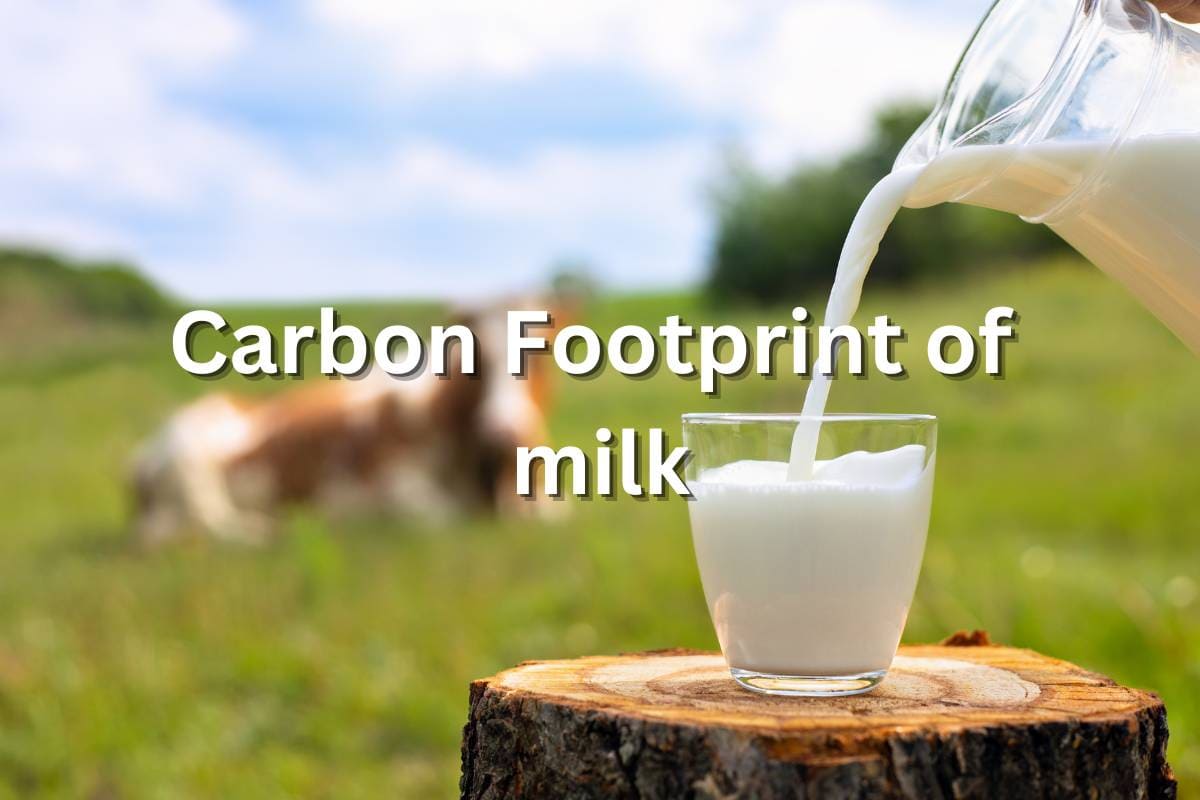The carbon footprint of producing one kilogram (2.2 pounds) of milk typically ranges between 1.2 and 2.4 kilograms (2.64 and 5.28 pounds) of CO2 equivalent (CO2e) (Our World in Data) (Frontiers). This footprint varies due to factors like farming practices and regional differences.
Factors Adding to the Carbon Footprint
The carbon footprint of milk production is influenced by several key factors:
- Feed Production: Growing and transporting feed, especially if it includes soy from deforested areas.
- Enteric Fermentation: Cows produce methane, a potent greenhouse gas, during digestion.
- Manure Management: Handling and storing manure releases methane and nitrous oxide.
- Energy Use: Electricity and fuel for milking equipment, cooling milk, and transporting it.
- Fertilizers: Using nitrogen-based fertilizers for feed crops emits nitrous oxide.
Interesting Facts
- Global Variations: The carbon footprint of milk can be as low as 0.8 kg (1.76 pounds) CO2e per kg in New Zealand and as high as 2.6 kg (5.72 pounds) CO2e per kg in some intensive farming systems.
- Efficiency Improvements: Over the past decade, improvements in farming practices have reduced the carbon footprint of milk by 19% in some regions. These advancements help decrease the emission of greenhouse gases and make milk production more sustainable.
- Sustainability Initiatives: Companies like Arla are implementing data-driven approaches to reduce their farms’ carbon footprints by 30% by 2030.
Tips to Reduce the Carbon Footprint of Milk
- Choose Organic Milk: Organic farming practices generally have a lower carbon footprint. Organic farms avoid synthetic fertilizers and pesticides, which reduces greenhouse gas emissions. Supporting organic milk production also encourages more sustainable farming practices.
- Buy Local Milk: Purchasing milk from local dairies reduces the emissions associated with transportation. This helps lower the overall carbon footprint of the milk you consume. Look for local brands or farmers’ markets to find fresh, local milk.
- Reduce Milk Waste: Only buy the amount of milk you need to avoid waste. Wasting milk means all the resources and emissions involved in its production are wasted too. Store milk properly to extend its shelf life and use it before it expires.
- Opt for Plant-Based Alternatives: Consider trying plant-based milk alternatives like almond, oat, or soy milk. These typically have a lower carbon footprint than dairy milk. Experiment with different options to find one that you enjoy and can easily incorporate into your diet.
- Support Sustainable Brands: Some dairy brands are actively working to reduce their carbon footprints. By choosing these brands, you can support their efforts and encourage more companies to adopt sustainable practices. Look for labels or certifications that indicate sustainability efforts.
- Use Recyclable Packaging: Choose milk that comes in recyclable packaging to reduce waste. Many brands offer milk in cartons or glass bottles that can be recycled. Properly recycling these containers helps reduce the environmental impact of your milk consumption.
Famous Initiatives to Reduce Milk’s Carbon Footprint
Arla’s Data-Driven Approach
Arla has developed the FarmAhead™ Check tool, allowing farmers to track and reduce their carbon footprints by analyzing data from their herds, feed production, and energy usage. This has helped them aim for a 30% reduction in CO2e per kilo of milk by 2030.
U.S. Dairy’s Feed in Focus Program
The U.S. Dairy Feed in Focus program helps farmers implement best practices in feed production and management to reduce greenhouse gas emissions. This includes cover cropping, reduced tillage, and nutrient stewardship.
What is the Carbon Footprint of 1 Glass of Milk?
A typical glass of milk is about 200ml (6.76 ounces). The carbon footprint for this amount of milk is approximately 0.24 to 0.48 kilograms (0.53 to 1.06 pounds) of CO2e . This footprint can vary based on the specific farming practices and region of production.
Drinking milk from farms that implement sustainable practices can reduce this footprint. Choosing local milk can also lower the carbon footprint by minimizing transportation emissions.
What is the Carbon Footprint of Skim Milk?
Skim milk generally has a slightly lower carbon footprint than whole milk. This is because skim milk requires less processing and often involves lower fat content which translates to fewer emissions in its production.
However, the difference in the carbon footprint between skim and whole milk is minimal. The main factors influencing the footprint remain the same, such as feed production and manure management.
How Much CO2 Does a Dairy Cow Produce?
A single dairy cow can produce around 2.5 to 4 kilograms (5.5 to 8.8 pounds) of CO2e per day from enteric fermentation. This includes methane emissions from digestion, which is a significant part of the dairy carbon footprint.
Additionally, manure management and feed production contribute to the total emissions per cow. Improved farming practices can help reduce these emissions significantly.
Which Milk Has the Lowest Carbon Footprint?
Plant-based milks generally have a lower carbon footprint compared to dairy milk. Among plant-based options, almond and oat milk have some of the lowest carbon footprints.
Almond milk typically has a footprint of about 0.7 kg (1.54 pounds) CO2e per liter, while oat milk is around 0.9 kg (1.98 pounds) CO2e per liter. This makes them more sustainable choices compared to cow’s milk.




